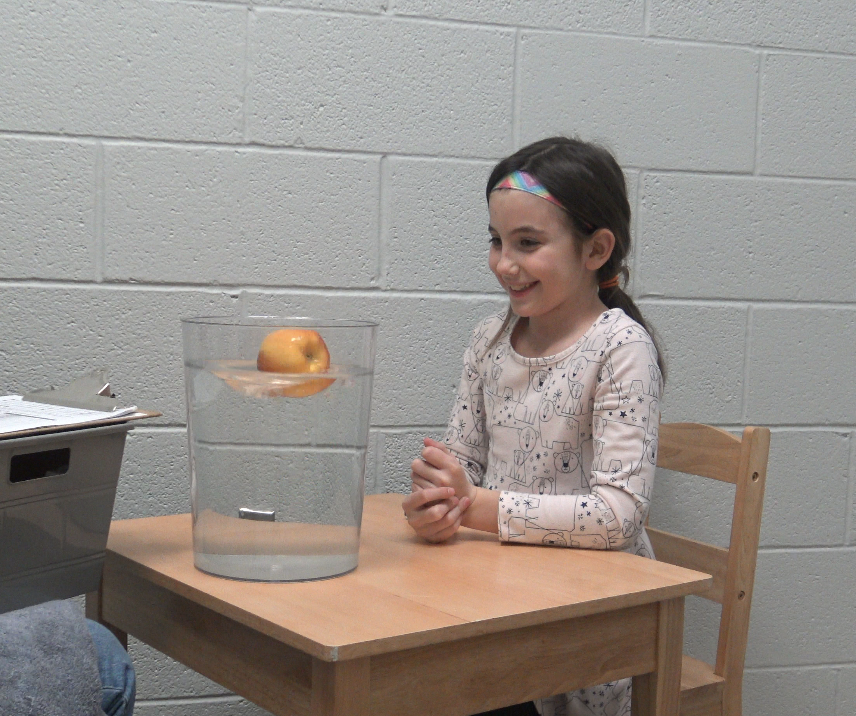
Will it Sink or Float?
No Gender Differences in Five- to Seven-year-old Children’s Science Task Engagement
Time to read: 3 minutes
Written By Nicole Stucke
Posted June 7, 2024
Addressing gender differences in science, technology, engineering, and mathematics (STEM) education and workforce participation has been a societal goal for decades.
Women make up nearly half (48%) of the U.S. workforce, but this number drops to 27% when focusing only on STEM fields1.
While there are more women in STEM fields now than ever before, there are still fewer women than men in STEM fields and at all levels of education.
These patterns are not that surprising given that by age 10, girls self-report weaker aspirations and less positive self-concepts in math and science compared to boys2-5. Some evidence suggests these differences may be traced back to gender-STEM stereotypes –– and the harmful downstream effects of such stereotypes –– emerging early in childhood.
We recently undertook a study exploring gender-science stereotypes in children and gender differences in persistence on a science task. Previous research6-8 suggests girls between 4 and 7 years may persist less than boys on science tasks, but we don't know if this pattern is related to gender-science stereotyping or whether the same pattern would be apparent on a physical science task (previous research used iPads).
One-hundred-and-nine local children between the ages of 5- to 7-years-old were invited to play a "sink or float" science task where they made predictions about whether various everyday household objects (an apple, a spoon, a carrot) would sink or float when dropped in a bucket of water. Kids could play the science game for up to 30 objects, opting to end the task whenever they wanted.
We measured how long children chose to engage with the science task, alongside other factors like what children thought about who can do and is good at science, their enjoyment of the science task, and their sink or float prediction accuracy.
Sample drawings from the “Draw-A-Scientist” Task
We found some evidence that children in our study held gender-related stereotypes about science. For example, in one task that assessed children’s implicit gender-science stereotypes, we told children:
“There were many good students in my school, but one of my classmates stood out from the rest. This student was especially good at science. This student could figure out problems that even the teachers couldn’t solve. One time, the student entered a science contest, and they answered all the questions right!“
We then asked, “Do you think the student is a boy or a girl?”
As a whole, children tended to answer that they thought the student was a boy. Across our stereotype measures, children generally tended to favor their own gender, but boys tended to favor boys more strongly than girls tended to favor girls –– consistent with stereotyping.
However, contrary to previous research, we did not find a difference between boys and girls in how long they opted to engage with the science task. Instead, children’s engagement was more closely linked to how much they enjoyed the science task and how accurate they were in their predictions. Kids who found the science game fun and were often correct in their predictions tended to stick with it longer. None of our other measures were related to children’s science task engagement.
Based on these findings, we conclude that more research is needed to better understand if, how, and when stereotypes affect younger girls’ science engagement. By continuing to explore these dynamics, we can better understand how to support and encourage all children in their early scientific pursuits.
…
Source:
Stucke, N. J. & Doebel, S. (under review) Will it Sink or Float? Examining Gender Differences in Science-task Persistence in Childhood and the Role of Gender-Related Stereotypes and Beliefs.
1 Martinez, A., & Christnacht, C. (2021). Women nearly half of workforce but only 27% of STEM workers. US Census Bureau.
2 Beghetto, R. A. (2007). Factors associated with middle and secondary students’ perceived science competence. Journal of Research in Science Teaching, 44(6), 800–814.
3 DeWitt, J., Osborne, J., Archer, L., Dillon, J., Willis, B., & Wong, B. (2013). Young children’s aspirations in science: The unequivocal, the uncertain and the unthinkable. International Journal of Science Education, 35(6), 1037–1063.
4 Stipek, D. J. (1984). Sex differences in children’s attributions for success and failure on math and spelling tests. Sex Roles, 11(11–12), 969–981.
5 Wilkins, J. L. M. (2004). Mathematics and science self-concept: An international investigation. The Journal of Experimental Education, 72(4), 331–346.
6 Gilligan, T., McNally, S., Lovett, J., Farell, T., Kumar, S., McLoughlin, E., & Corriveau, K. (2023). Persistence in science play and gender: Findings from early childhood classrooms in Ireland. Early Education and Development, 34(4), 927–939.
7 Kumar, S. C., Haber, A. S., Ghossainy, M. E., Barbero, S., & Corriveau, K. H. (2023). The impact of visualizing the group on children’s persistence in and perceptions of STEM. Acta Psychologica, 233, 103845.
8 Shachnai, R., Kushnir, T., & Bian, L. (2022). Walking in her shoes: Pretending to be a female role model increases young girls’ persistence in science. Psychological Science, 33(11), 1818–1827.


